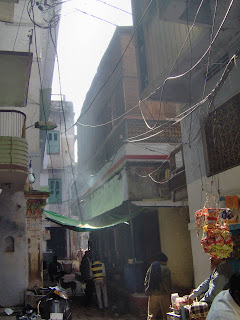As with so much else, it's difficult to put Varanasi into words. It's the spiritual pulse on the banks of the Ganges. It's the home to Benares Hindu University (BHU), jewel in India's diadem of education. It's a center for the arts and has been home to painters and writers and musicians since time immemorial. It also houses wonderful restaurants and twisting alleyways.
Varanasi is ancient and is not the original name of the city. It's home to about a half million people, but you don't feel it until you're out in the streets. On every corner is a shrine. Krishna, Vishnu, Hanuman and especially Shiva are ever-present. Shiva with his trident (and lingam) rests side by side with his wife Ganga Ma and she is beautiful. As I write this, I well up with a huge sense of love for her, too. It might be, as some have said (Krishnamurti and His Holiness the Dalai Lama) that a place imbued with centuries (millenia, in this case) of love and reverence cannot help but evoke that feeling in others.
Traveling up the river on one side, you see history before your eyes - the ghats, built by royal devotees from all around India to ensure their acceptance into heaven; some by Moghuls, a couple by the British. Many have temples incorporated to their schemes. Then there are the cremation ghats; these I do not photograph for the same reasons that certain temples I don't record: they are sacred and private in ways that we perhaps have forgotten with our automatic reflex to upload, post and share.
Varansi and Sarnath close by have captured my heart in a way different than Dharamsala or Bodhgaya; each place has its distinct allure and sense of home, sense of welcome.
What follows are a handful of photos. Not many because I'm finding limitations on beach shots, on river compositions, on scenic twists and turns of said alleyways. The actual experience is a treasure; the photo, a cliche. But I share them with you because I want to share something of the visceral experience of where I've been, what I've seen.
The Ghats
The Alleys
Facades and random finds:
Varanasi is ancient and is not the original name of the city. It's home to about a half million people, but you don't feel it until you're out in the streets. On every corner is a shrine. Krishna, Vishnu, Hanuman and especially Shiva are ever-present. Shiva with his trident (and lingam) rests side by side with his wife Ganga Ma and she is beautiful. As I write this, I well up with a huge sense of love for her, too. It might be, as some have said (Krishnamurti and His Holiness the Dalai Lama) that a place imbued with centuries (millenia, in this case) of love and reverence cannot help but evoke that feeling in others.
Traveling up the river on one side, you see history before your eyes - the ghats, built by royal devotees from all around India to ensure their acceptance into heaven; some by Moghuls, a couple by the British. Many have temples incorporated to their schemes. Then there are the cremation ghats; these I do not photograph for the same reasons that certain temples I don't record: they are sacred and private in ways that we perhaps have forgotten with our automatic reflex to upload, post and share.
Varansi and Sarnath close by have captured my heart in a way different than Dharamsala or Bodhgaya; each place has its distinct allure and sense of home, sense of welcome.
What follows are a handful of photos. Not many because I'm finding limitations on beach shots, on river compositions, on scenic twists and turns of said alleyways. The actual experience is a treasure; the photo, a cliche. But I share them with you because I want to share something of the visceral experience of where I've been, what I've seen.
The Ghats
 |
| The main ghat is replete with festivals, a bazaar and temples. |
The Alleys
Facades and random finds:














































No comments:
Post a Comment